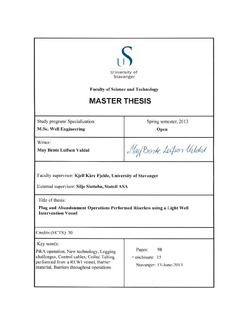| dc.description.abstract | In a few years there will be a significant increase in wells that need to be permanently plugged and abandoned
(PP&A). Statoil operates around 500 subsea wells on the Norwegian Continental Shelf (N.C.S), whilst there
exist around 5000 subsea wells worldwide. Some older wells could be extremely challenging to plug, since
abandonment requirements were not taken fully into account when the wells were planned, drilled and
completed. In later years new requirements have also been implemented for plug and abandonment.
Statoil has now increased focus on Plug and Abandonment (P&A), this Thesis is written by request by Statoil.
Due to continuing high oil prices, new field discoveries and general optimism in the market, there is currently a
shortage of conventional semi-submersible rigs. The future demand for more semi-submersible rigs or other
alternatives is likely. For a permanent plug and abandonment operation the main goals are to complete the
operation of the well in a safe and cost-effective manner. In this context it is anticipated that some wells could
be abandoned in the future solely by a monohull Riserless Light Well Intervention vessel (RLWI). The day rate
of a RLWI vessel is significantly less expensive than for an ordinary rig. Traditionally, P&A on subsea wells are
intervened by semi-submersible rigs with marine risers. To perform the P&A operation from a RLWI vessel,
the development of new technology to overcome some challenges is required. The main challenges
demanding new technology identified today includes how to establish the primary and secondary barriers in
wells which contain control lines attached to the tubing, and/or wells where the outer barrier element, i.e. the
casing cement, is either not verified, not present or in poor condition, and the possibility to remove the tubing
and placement of the barrier.
The scope of work for this Thesis has been to show that the final plug and abandonment operations that are
conventionally being performed using semi-submersible rigs can be performed entirely from a RLWI vessel.
The focus has been on equipment and methods to manage to execute the operation. The P&A operation is
premised executed with required barriers in place during entire operation and for less cost than for a rig. The
Thesis will identify the gaps in technology, attempting to identify status and propose possible solutions, look
into the possibility to use Coiled Tubing on a light well intervention without a marine riser, and operations and
weather analysis behaviour of semi-submersible rigs and RLWI vessels.
This Master Thesis will describe how it would be possible to perform a final plug and abandonment job using a
RLWI vessel, and address further technology development needed for RWLI P&A operations. The new
operation would lead to more cost efficient P&A operations for subsea wells. The semi-submersible rigs can
thus focus on drilling and completion of new wells and thus increase the efficiency of the total well cycle of well
planning, well construction and P&A, and thereby increase the revenue for the operating companies. | no_NO |
